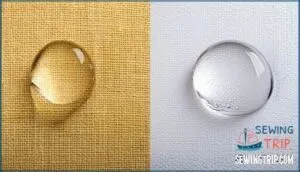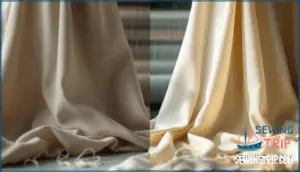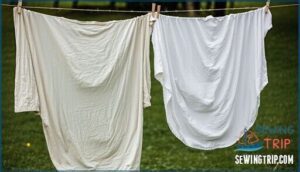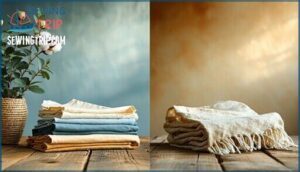This site is supported by our readers. We may earn a commission, at no cost to you, if you purchase through links.
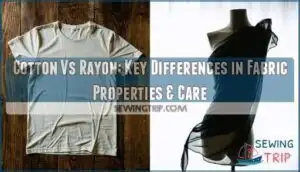
Cotton and rayon might both feel comfortable against your skin, but their behavior under stress, moisture, and repeated wear tells a completely different story. Cotton’s natural fiber structure holds up when you tug a sleeve or stretch fabric during movement, while rayon—despite its silky drape—loses integrity faster than you’d expect.
Understanding how these fabrics actually perform helps you choose clothes that last and feel right for what you need them to do.
Table Of Contents
Key Takeaways
- Cotton wins on durability because its natural fiber structure resists breaking under stress and holds up through repeated washing, while rayon weakens dramatically when wet and requires gentler care to prevent rapid deterioration.
- Rayon feels silkier and drapes more elegantly than cotton, but cotton delivers better breathability and thermal regulation, making it more comfortable for all-day wear in varying temperatures.
- Cotton absorbs significantly more water overall (up to 25 times its weight) and dries faster than rayon, which means better moisture management and quicker laundry turnaround for everyday use.
- Cotton costs less upfront and delivers better long-term value because you’ll replace rayon garments twice before a cotton piece wears out, making it the more cost-effective choice despite rayon’s premium drape.
Strength and Durability
When you’re choosing between fabrics, knowing how they’ll hold up matters. Cotton and rayon manage wear and tear differently, and that gap shows up in everything from how strong the fibers are to how long your clothes last.
Let’s look at how these two stack up regarding strength and staying power.
Cotton Vs Rayon: Tensile Strength
Regarding fabric tension and material science, cotton outperforms rayon in tensile strength. Cotton’s natural fibers have a sturdy cellular structure that resists breaking under stress, making it ideal for textile testing and strength comparison. Rayon, despite its smooth texture, loses structural integrity when pulled—its regenerated cellulose fibers simply can’t match cotton’s resilience.
This fiber analysis matters if you’re choosing fabrics for everyday wear. Cotton manages stress better, whether you’re tugging on a sleeve or stretching fabric during weaving. For practical durability, natural fibers like cotton win the tensile strength battle. Consumers can also explore sleep trial options to find the best fabrics for their needs.
Cotton Vs Rayon: Durability and Longevity
When you’re buying fabrics that need to hold up long-term, knowing how cotton and rayon manage repeated use makes all the difference. Cotton’s strong cellular structure resists material degradation through countless wash cycles, maintaining wear resistance that rayon can’t match. Rayon weakens dramatically when wet, leading to fiber breakage and stretching. Longevity tests consistently show cotton outlasting rayon in real-world conditions:
- Cotton maintains fabric lifespan through repeated washing and daily wear
- Rayon tears easily when wet, reducing durability
- Cotton resists abrasion better in high-stress areas
- Rayon requires careful treatment to prevent rapid deterioration
For fabric comparison, cotton wins the durability battle.
Absorbency
When you’re choosing between cotton and rayon, how each fabric manages moisture makes a real difference in comfort and performance. Cotton and rayon absorb water differently, which affects everything from how they feel against your skin to how quickly they dry.
Let’s compare how these two fabrics stack up regarding moisture absorption and breathability.
Cotton Vs Rayon: Moisture Absorption
You’ll notice cotton and rayon manage moisture quite differently—and the numbers tell the story. Cotton holds 7–11% moisture regain under standard conditions and can absorb up to 25 times its weight in water. Rayon’s moisture regain sits higher at 11.5–12.5%, but it absorbs only about 50% more than its own weight. That means cotton takes in markedly more water overall.
However, rayon responds more dramatically to humidity effects, with specialty versions reaching nearly 30% moisture regain at high humidity. Cotton wets faster—around 2.83 seconds for finer weaves—while rayon lags slightly behind. Both fabrics are hydrophilic, but their absorption rates and water uptake behave differently depending on fabric structure and environmental conditions.
The choice between cotton and rayon often depends on understanding fabric properties and their impact on the final product.
Cotton Vs Rayon: Breathability
Moisture absorption matters, but breathability is where you really feel the difference between these two fabrics. Cotton wins here—its natural fiber structure creates better air permeability and fabric ventilation than rayon. You’ll stay cooler in cotton because it allows more airflow through the weave. Rayon does offer decent moisture wicking, but cotton’s thermal regulation keeps you comfortable longer. Both qualify as breathable fabrics, though cotton edges ahead for all-day wear.
Why breathability matters in your fabric comparison:
- Cotton’s open weave lets your skin breathe freely during hot days
- Natural fiber advantage means less trapped heat against your body
- Better airflow reduces that clammy feeling after sweating
- Thermal regulation keeps you comfortable across temperature changes
- Real ventilation beats synthetic alternatives when comfort counts
Softness and Texture
When you’re choosing between cotton and rayon, how the fabric feels against your skin matters just as much as how it performs. The texture and softness of these two materials differ in ways that affect everything from everyday comfort to formal elegance.
Let’s compare how cotton and rayon measure up regarding comfort and appearance.
Cotton Vs Rayon: Comfort and Feel
The moment you touch cotton or rayon, you’ll feel a world of difference between these two fabrics. Cotton delivers that classic, breathable softness your skin craves—it’s absorbent and gentle, especially if you deal with skin sensitivity. Rayon? It’s got a silky drape quality with smooth moisture absorption that feels cool against your body. Both offer excellent wear comfort, but cotton wins for everyday breathability, while rayon gives you that luxurious feel.
- Cotton: Natural fabric softness with exceptional breathability for all-day comfort
- Rayon: Silky smooth drape with moisture-wicking properties
Cotton Vs Rayon: Texture and Luster
When you run your fingers across cotton and rayon side by side, the difference in surface texture tells you everything you need to know about each fabric’s character. Cotton’s fabric smoothness feels naturally matte with a slight grain you can sense, while rayon delivers that silk-like material shine that catches light beautifully.
The fiber appearance depends on weave patterns and yarn quality—cotton stays humble and breathable, rayon goes for visual drama with its lustrous surface that elevates any textile.
| Property | Cotton | Rayon |
|---|---|---|
| Surface Feel | Slightly textured, matte finish | Silky smooth, cool to touch |
| Visual Luster | Low shine, natural appearance | High sheen, lustrous drape |
| Tactile Character | Soft grain, absorbent texture | Slippery smoothness, refined |
Elasticity and Stretchiness
When you’re choosing between cotton and rayon, understanding how each fabric manages movement stretches matters more than you might think.
Cotton and rayon manage movement differently, which affects everything from how your clothes fit to how long they last.
Let’s break down what you need to know about their stretchability and elasticity.
Cotton Vs Rayon: Stretchability
If you’ve ever yanked at a favorite shirt or tugged on a dress hem to see how much give it has, you’re already testing stretchability. Cotton naturally stretches about 5% of its length, giving it solid fabric flexibility and fiber resilience—perfect for garments that move with you. Rayon, on the other hand, doesn’t have much yarn extension on its own. It’s fairly rigid compared to cotton. That’s why manufacturers often blend both fabrics with synthetic fibers like spandex to boost elastic recovery and overall stretch factors.
Here’s what affects their stretchability:
- Cotton’s natural structure allows moderate stretch without permanent deformation
- Rayon lacks inherent elasticity due to its regenerated cellulose composition
- Blending with elastane dramatically improves both fabrics’ performance
- Weave pattern influences final garment stretch more than fiber type alone
Cotton Vs Rayon: Elasticity
Elasticity isn’t just about whether a fabric stretches—it’s about whether it snaps back to its original shape after you’ve stretched it. With cotton, you get a decent balance of stretchability and elastic recovery, thanks to its natural fiber flexibility and material resilience.
Rayon, however, generally offers less textile extension and rarely returns to form once pulled. If you’re after fabric stretch that lasts, cotton outshines rayon for comfort and everyday performance.
Wrinkle Resistance
Wrinkles are one of those everyday annoyances that can make or break how your clothes look after a day of wear. Cotton and rayon manage wrinkles differently, which affects how much time you’ll spend with an iron.
Here’s how each fabric stacks up regarding staying smooth.
Cotton Vs Rayon: Wrinkle Formation
Wrinkles don’t discriminate, but fabrics certainly differ regarding how they manage the creases and folds of daily wear. Cotton wrinkles easily because its natural fibers lack elasticity and hold creases once they form.
Rayon, with its smooth surface and synthetic processing, resists wrinkling better than cotton. If fabric smoothness matters to you, rayon stays fresher longer without constant steaming or ironing. Cotton needs more attention to maintain that crisp look throughout your day.
Cotton Vs Rayon: Wrinkle Resistance
Choosing between cotton and rayon for wrinkle resistance might surprise you—the answer flips what you just read on its head. Rayon actually holds up better against wrinkling than cotton does. That’s because rayon’s semi-synthetic processing creates smoother fibers that resist creasing during wear. Cotton’s natural structure, while breathable and durable, catches folds easily and holds them stubbornly.
Here’s what makes rayon the winner for fabric smoothness:
- Wrinkle-free mornings: Rayon garments need less attention before you head out the door
- Fabric relaxation: Rayon fibers naturally release minor creases as you move throughout your day
- Steaming methods work faster: A quick pass with a steamer refreshes rayon textile pieces instantly
- Ironing tips simplified: When rayon does wrinkle, low-heat pressing restores its drape quickly
Cotton demands more maintenance if you want that crisp look. Regular ironing becomes part of your routine with cotton clothing, while rayon maintains its polished appearance with minimal effort.
Environmental Impact
When you compare fabrics, the story doesn’t end with how they feel or wear—it extends to how they affect the planet. Both cotton and rayon carry environmental costs, though they take different paths to your closet.
Let’s break down what sustainability and production really mean for these two popular fabrics.
Cotton Vs Rayon: Sustainability
Sustainability remains a tricky balance between two imperfect choices. Cotton demands roughly 10,000 liters of water per kilogram—a massive burden on regions already facing water scarcity. That’s why water conservation efforts matter so much for this natural fiber.
Rayon’s carbon footprint can actually be lower, especially with sustainable production using certified forests and closed-loop systems that recover 99% of solvents. Yet traditional rayon processing still contributes to deforestation and chemical pollution.
For truly eco-friendly fashion and green textiles, you’ll want organic cotton or innovative rayons like lyocell—both sustainable clothing options that minimize environmental harm while delivering the performance you need.
Cotton Vs Rayon: Production Processes
Both fabrics start from natural cellulose, but their manufacturing techniques couldn’t be more different. Cotton undergoes fiber extraction straight from the cotton plant—ginning separates seeds from lint, which gets cleaned and pressed into bales before spinning into yarn. That’s textile manufacturing at its most straightforward.
Rayon’s chemical processing tells another story. Wood pulp or cotton linters go through alkali treatment, then get bathed in carbon disulfide to create cellulose xanthate. The viscose solution passes through spinnerets into sulfuric acid, regenerating into filaments.
Raw material sourcing from forests raises deforestation concerns, while these harsh chemicals create a significant environmental footprint that sustainable cotton farming—even with its heavy water use—often avoids.
Care and Maintenance
Taking care of cotton and rayon properly makes a real difference in how long your fabrics last. The two materials need different approaches regarding washing, drying, and general upkeep.
Here’s what you need to know about keeping each fabric in good shape.
Cotton Vs Rayon: Cleaning and Washing
When you toss a cotton shirt and a rayon blouse into the wash together, you’re treating two fabrics that couldn’t be more different in their cleaning needs. Cotton manages machine washing like a champ—hot water, standard detergents, and vigorous cycles won’t faze it. It resists stains well but may experience fabric shrinkage if you use high heat.
Rayon demands gentler treatment in the textile industry. Cold water and mild soap prevent color bleeding, and you’ll want to skip the bleach entirely.
For drying techniques, cotton tolerates the dryer while rayon prefers air-drying to maintain its shape and texture.
Cotton Vs Rayon: Special Handling or Care Instructions
Beyond the basics of washing and drying, both fabrics need a few extra precautions to stay in their best shape. Cotton withstands ironing at medium-high heat with steam, but watch for fabric shrinkage if you’re working with untreated pieces. Rayon requires low heat and a pressing cloth to protect its delicate fibers during ironing sessions.
For drying methods, cotton tolerates machine drying, while rayon benefits from air-drying flat to maintain breathability and structure. Storage advice matters too:
- Cotton: Store in well-ventilated spaces to prevent mildew; it’s naturally resilient but appreciates gentle washing for longevity.
- Rayon: Keep away from moisture and direct sunlight, as this fabric care approach prevents weakening and color fading in your laundry routine.
Cost and Affordability
When you’re choosing between cotton and rayon, price often plays a bigger role than you might expect. The cost difference between these two fabrics can affect not just your initial purchase, but how much value you get over time.
Let’s break down what you’re actually paying for and whether the price tag matches what you’re getting.
Cotton Vs Rayon: Price Comparison
Cotton usually wins the price battle in the textile industry. Cotton fabric costs less per yard compared to rayon—largely because cotton production expenses have stabilized over decades of farming infrastructure. Rayon’s chemical processing drives up production expenses, making it pricier at retail.
Market trends show cotton hovering around $3-6 per yard for standard weaves, while rayon starts closer to $7-10. Price fluctuation hits rayon harder when raw material value shifts, especially wood pulp costs.
For everyday clothing, cotton vs rayon comes down to this: cotton delivers consistent fabric costs, while rayon brings premium pricing for its silky drape.
Cotton Vs Rayon: Value for Money
Your wallet feels the pinch differently depending on whether you’re thinking short-term savings or long-term value. Cotton delivers better cost effectiveness over time—you’ll replace rayon garments twice before your cotton shirt wears out.
That’s why budget options aren’t always the cheapest price points. Fabric quality matters when comparing cotton vs rayon. Cotton offers solid value comparison: higher durability per dollar spent on textile purchases. Rayon’s appeal fades when weaving longevity into your buying decisions.
Uses and Applications
When you’re choosing between cotton and rayon, where you plan to use the fabric matters just as much as how it feels or performs. Each material has carved out its own space in different applications, from the clothes in your closet to the linens on your bed.
Let’s break down where each fabric really shines.
Cotton Vs Rayon: Clothing and Apparel
From your morning tee to your evening dress, these two fabrics shape what you wear more than you might realize. Cotton dominates casual clothing—think breathable shirts, underwear, and denim—while rayon brings that silk-like drape to dresses and blouses. The apparel industry often creates fabric blends to balance cotton’s durability with rayon’s luxurious feel, giving you garment quality that meets evolving fashion trends.
Why your clothing comfort depends on fabric choices:
- Cotton keeps you cool during summer workouts, wicking moisture away naturally
- Rayon drapes beautifully for formal occasions, though it needs gentler care
- Blended fabrics give you the best of both—strength meets elegance in one garment
Cotton Vs Rayon: Home Textiles and Furnishings
The fabrics filling your home—from curtains filtering morning light to cushions cradling you on the couch—work harder than most people think. Cotton dominates upholstery materials because it can withstand daily wear without falling apart. You’ll find it in sofas, throw pillows, and tablecloths where durability matters. Rayon brings elegance to home decor through luxurious drapes and decorative accents, though it needs more careful management than cotton.
Your fabric choices for home textiles depend on practical needs:
- Cotton works best for high-traffic furniture fabrics that need frequent washing
- Rayon elevates formal spaces with its silk-like drape in curtains and decorative throws
- Blended textile selection combines both fibers for balanced performance in bedding
Frequently Asked Questions (FAQs)
Which fabric is more environmentally friendly, cotton or rayon?
Picture two paths through a forest—one wild and sprawling, the other paved but at a cost. Neither cotton nor rayon walks away clean.
Cotton devours water and pesticides, while rayon’s chemical processing can fuel deforestation.
Organic cotton tips the scales toward sustainability, making natural fiber the greener choice for ecofriendly fashion.
Can rayon be blended with other fabrics to enhance its durability?
Yes, fabric blending strengthens rayon markedly. Textile mixing with cotton, polyester, or nylon creates rayon hybrids that resist wear better.
Fiber reinforcement through fabric production methods improves material enhancement, making blended textiles more durable than pure rayon for everyday use.
Does cotton or rayon have better wrinkle resistance?
Rayon wrinkles more easily than cotton. Cotton’s natural fiber structure holds its shape better, while rayon—despite its silk-like drape—creases quickly without proper textile finishing. You’ll spend less time ironing cotton garments.
Which fabric is more suitable for sensitive skin, cotton or rayon?
When your skin craves gentleness, cotton wins hands down. Its natural breathability and absorbent fibers make it hypoallergenic, minimizing skin irritation and allergy risks.
Rayon’s chemical processing can trigger dermatological effects, while cotton’s softness offers exceptional comfort for sensitive skin.
Is cotton or rayon more cost-effective in terms of affordability?
Regarding Fabric Costs, cotton usually wins on affordability. Production Expenses for cotton are lower, making it more accessible for everyday clothing materials.
Rayon’s chemical processing raises costs slightly, though both offer Budget Analysis options depending on your needs.
Which fabric is better for sensitive skin?
Like a gentle whisper against bare skin, fabric choice matters when irritation strikes. Cotton wins for Sensitive Skin—it’s naturally Breathable, Absorbent, and Softness shines without chemical processing.
Rayon’s manufacturing introduces Allergy Risks and potential Skin Irritation, despite feeling silky.
Does rayon pill more than cotton fabric?
Generally, rayon is prone to pilling more than cotton fabric. Rayon’s weaker fiber structure makes it prone to fraying and fabric pilling, especially after repeated wear and washing, reducing textile quality and material durability over time.
Can you mix cotton and rayon in wash?
You’ll notice your laundry load feels lighter when you separate delicate fabrics from sturdy ones.
You can mix cotton and rayon in the wash, but use cold water and a gentle cycle to prevent rayon from weakening or shrinking while protecting cotton’s color.
Which fabric dries faster after washing?
Cotton dries faster after washing. Its breathability and lower water absorption mean quicker moisture removal compared to rayon’s denser weave.
This shorter drying time also helps reduce fabric shrinkage, making cotton the better quick-dry choice.
Is rayon warmer or cooler than cotton?
On humid summer days, you’ll notice rayon clings while cotton stays fresh—that’s breathability at work. Rayon usually feels cooler initially due to its smooth texture and drape, but cotton offers greater temperature regulation and breathability factors.
Cotton’s absorbent fibers and durability make it better for seasonal wear requiring thermal insulation.
Conclusion
Your clothes tell the truth about the cotton vs rayon difference every time you wash them. Cotton holds its shape through repeated wear because its natural fibers resist breakdown, while rayon’s manufactured structure weakens when wet. That sleeve you tugged or shirt collar you adjusted? Cotton remembers its original form. Rayon doesn’t.
Choose based on what matters more: durability that survives your routine, or drape that demands gentler care.

